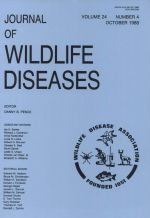Meperidine HCl was administered intramuscularly by hand-syringe to a number of individuals representing several species of cetaceans (n = 95) and pinnipeds (n = 36). Dosage administered was 0.11 mg/kg, 0.23 mg/kg or 0.45 mg/kg, with the majority of animals receiving the middle dosage. Meperidine HCl provided moderate restraint in cetaceans without obvious deleterious effects. Restraint was achieved rapidly, with maximum effect occurring 20 min after intramuscular injection and lasting for 2 to 3 hr. Analgesia appeared to last as long as 4 hr and was sometimes accompanied by a restoration of appetite in animals suffering from physical discomfort. Higher doses produced increased sedation and analgesia without noticeably depressing respiration. Meperidine HCl provided moderate restraint for phocids and walrus (Odobenus rosmarus) without apparent detriment. California sea lions (Zalophus californianus) showed little restraint, but demonstrated profound respiratory depression.
How to translate text using browser tools
1 October 1988
The Use of Meperidine Hydrochloride for Chemical Restraint in Certain Cetaceans and Pinnipeds
Brian E. Joseph,
Lanny H. Cornell

Journal of Wildlife Diseases
Vol. 24 • No. 4
October 1988
Vol. 24 • No. 4
October 1988
cetaceans
Chemical restraint
comparative immobilization studies
meperidine HCl
pinnipeds




